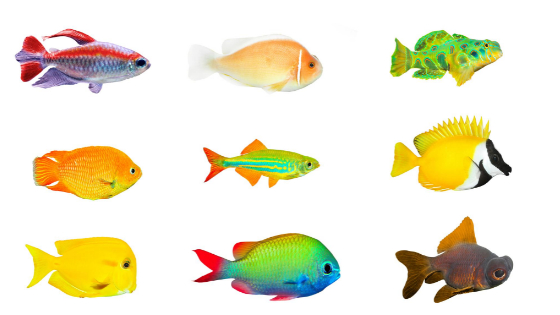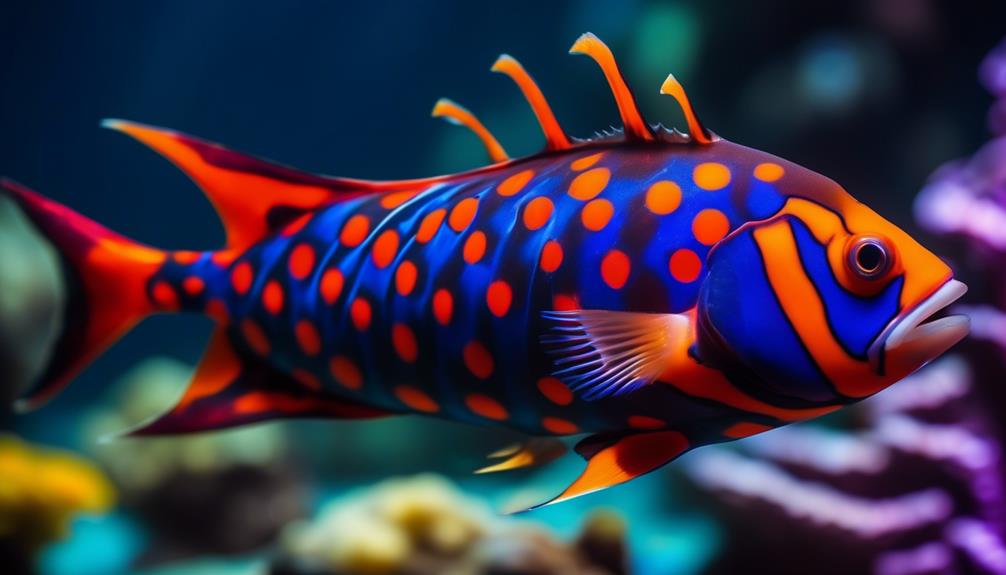
As the sun descends below the horizon, casting a golden glow over the tranquil ocean waters, a mysterious creature emerges from the depths, captivating all who lay eyes upon it.
The Harlequin Tuskfish, with its intricate patterns and fierce countenance, is a mesmerizing sight to behold. But beyond its exquisite appearance lies a predator that strikes fear into the hearts of its fellow marine inhabitants.
What secrets does this enigmatic fish hold? What makes it both captivating and dangerous? Join us on a journey into the world of the Harlequin Tuskfish, where beauty and ferocity intertwine in a delicate dance of survival.
Key Takeaways
- The harlequin tuskfish is a highly colorful species of wrasse with distinctive body colorations and sharp blue, tusk-like teeth.
- It is a medium-sized saltwater fish with a non-aggressive temperament.
- The fish originates from the Western Pacific Ocean, specifically Australia and the Philippines, with specimens from Australia often being in better condition.
- The harlequin tuskfish requires a large aquarium with open swimming spaces and hiding places, and it has a carnivorous diet consisting of krill, shrimp, squid, and fish.
Description and Characteristics
The Harlequin Tuskfish is a highly colorful species of wrasse, known for its distinctive body colorations and sharp blue, tusk-like teeth. This medium-sized saltwater fish has a non-aggressive temperament and is a popular choice for large aquariums. It can be found swimming in all regions of the aquarium.
The Harlequin Tuskfish is a hardy species that acclimatizes well to life in captivity. It originates from the Western Pacific Ocean and is commonly found in Australia and the Philippines. However, specimens caught in Australia are often in better condition. This species is fairly expensive in the aquarium trade, with juveniles costing in excess of $50.
In terms of care, the Harlequin Tuskfish is an extremely fast-growing fish that can reach 8-10 inches in length. It requires a large aquarium with wide open swimming spaces and prefers aquariums with numerous hiding places. However, it isn't suitable for reef aquariums due to its prey habits.
As a carnivore, it should be fed a diet consisting of krill, shrimp, squid, and fish. It preys heavily on small species of crustaceans and can occasionally consume smaller fish.
Origins and Availability
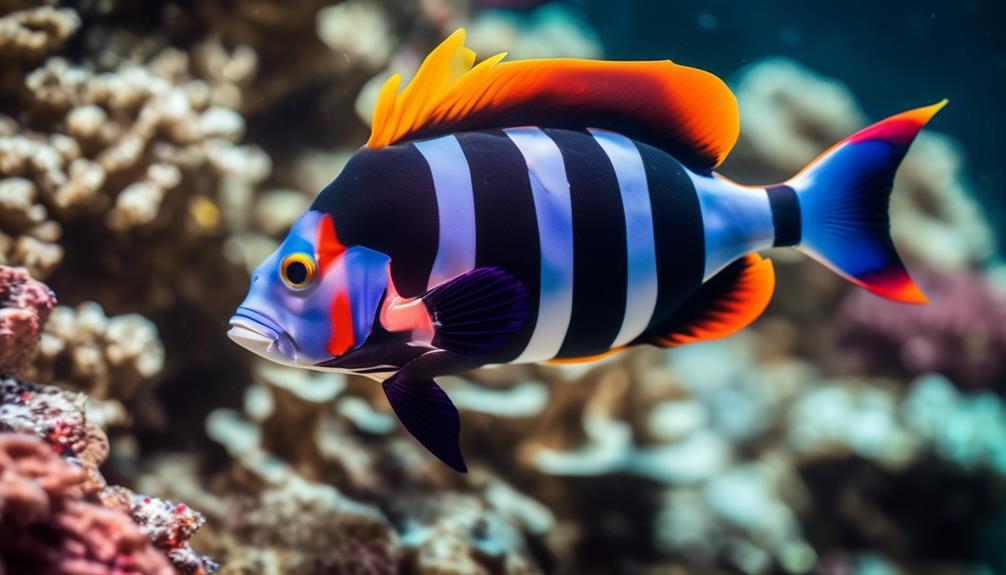
Originating from the Western Pacific Ocean, the Harlequin Tuskfish is commonly found in Australia and the Philippines. When it comes to availability, most specimens available for purchase in the aquarium trade come from these two countries.
However, there are a few important factors to consider. Firstly, specimens caught in Australia are often in better condition compared to those from the Philippines. Secondly, this species is fairly expensive, with juveniles often costing in excess of $50.
These factors should be taken into account when considering adding a Harlequin Tuskfish to your aquarium.
Maintenance and Care
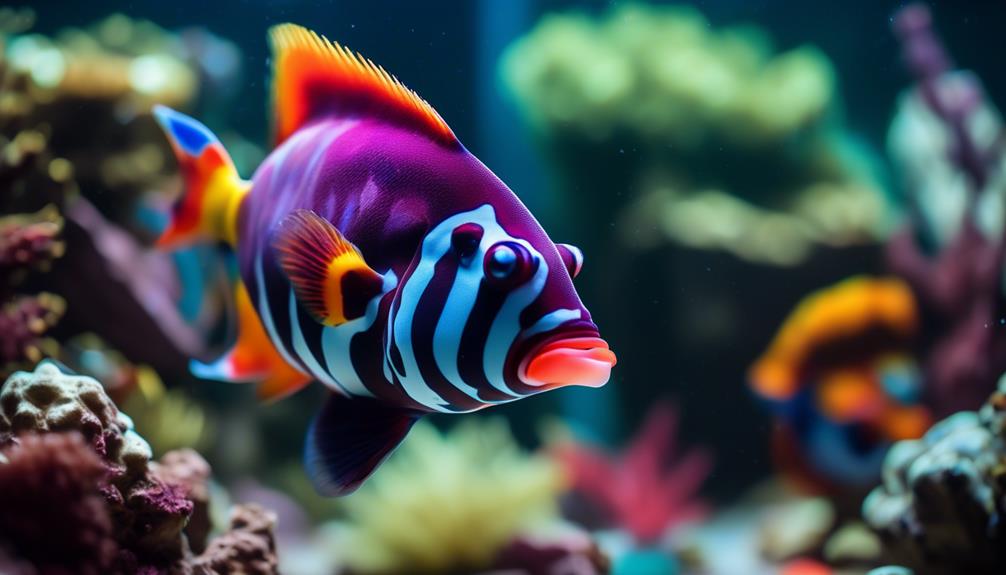
To properly care for a Harlequin Tuskfish in your aquarium, it is important to consider their specific maintenance requirements. These fast-growing fish can reach lengths of 8-10 inches in captivity, so a sufficiently large aquarium with wide open swimming spaces is necessary. They also prefer aquariums with numerous hiding places. However, it's important to note that they are not suitable for reef aquariums due to their predatory habits.
In order to maintain their health, Harlequin Tuskfish should be fed a carnivorous diet consisting of krill, shrimp, squid, and fish. They are known to prey heavily on small species of crustaceans, and may also devour snails, clams, echinoderms, and other small invertebrates. Occasionally, they may even prey on smaller fish.
Overall, providing the proper space and diet is crucial for the well-being of Harlequin Tuskfish in your aquarium.
| Maintenance and Care |
|---|
| Requires large aquarium with open swimming spaces |
| Prefers aquariums with hiding places |
| Not suitable for reef aquariums |
| Carnivorous diet of krill, shrimp, squid, and fish |
| Preys on small crustaceans and invertebrates |
Feeding Habits
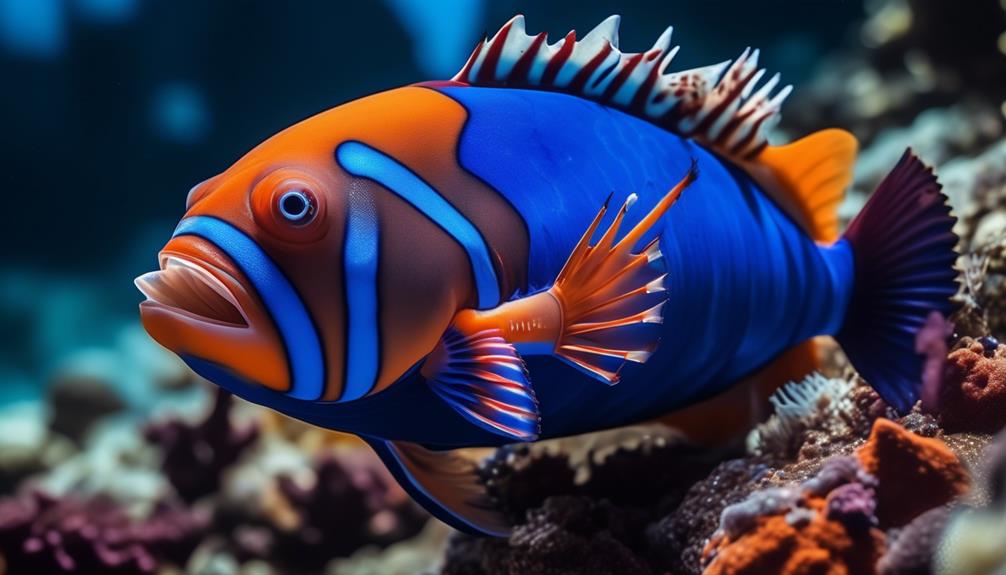
Harlequin Tuskfish have a carnivorous diet, consisting of krill, shrimp, squid, and fish. They prey heavily on small species of crustaceans, devouring snails, clams, echinoderms, and other small invertebrates. Their sharp blue, tusk-like teeth enable them to crush the shells of their prey with ease. Additionally, they can occasionally prey on smaller species of fish, making them formidable hunters in the underwater world.
Their feeding habits reflect their predatory nature and highlight their role as top-level carnivores in their ecosystem. It's important for aquarium owners to provide a meaty diet for these fish to ensure their nutritional needs are met. By understanding their feeding habits, enthusiasts can create a suitable environment for the harlequin tuskfish in captivity, allowing them to thrive and exhibit their natural behaviors.
Additional Notes
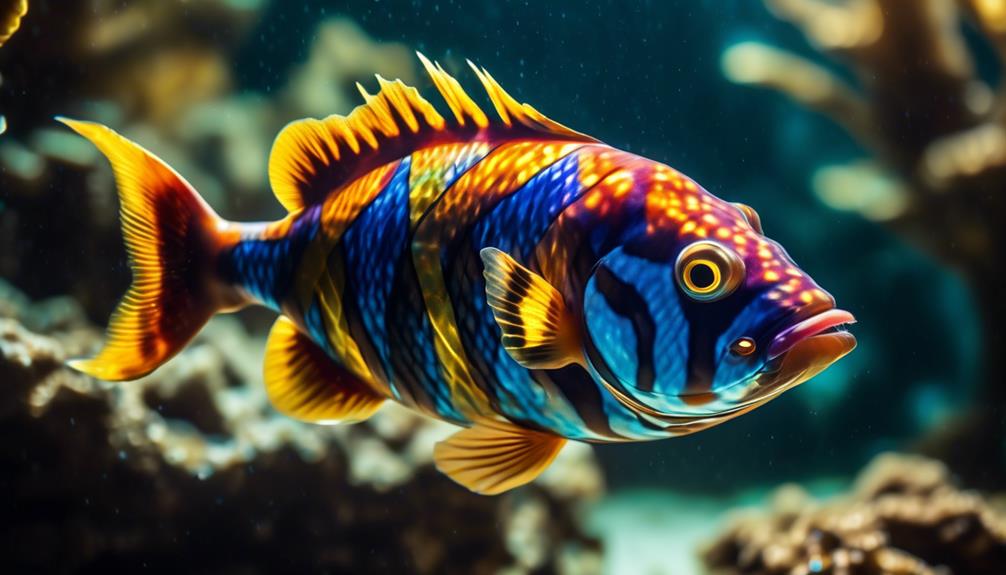
As we explore further, it is important to consider a few additional notes about the harlequin tuskfish. This captivating species of wrasse is known for its distinctive body colorations and sharp, tusk-like teeth. Native to the Western Pacific Ocean, most specimens available in the aquarium trade come from Australia and the Philippines. It's worth noting that specimens caught in Australia are often in better condition. The harlequin tuskfish is a carnivorous fish that requires a sufficiently large aquarium with wide open swimming spaces and numerous hiding places. It is not suitable for reef aquariums due to its prey habits. When it comes to feeding, this species primarily consumes a meaty diet consisting of krill, shrimp, squid, and fish. However, it is important to remember that the provided content is not comprehensive, and additional research may be required.
| Characteristic | Description |
|---|---|
| Size | Medium |
| Group | Saltwater |
| Temperament | Non-aggressive |
| Aquarium Size | Large (55 gal) |
| Swimming Region | All |
| Coloration | Highly colorful |
| Teeth | Sharp blue, tusk-like teeth |
| Origin | Western Pacific Ocean |
| Availability | Most specimens from Australia and the Philippines |
| Maintenance | Requires large aquarium with open swimming spaces and hiding places |
| Feeding Habits | Carnivorous, primarily eats krill, shrimp, squid, and fish |
| Reef Compatibility | Not suitable for reef aquariums |
| Price | Fairly expensive in the aquarium trade, juveniles often cost over $50 |
| Additional Note | The content provided is not comprehensive and additional research may be required |
Frequently Asked Questions
What Is the Lifespan of a Harlequin Tuskfish?
The lifespan of a harlequin tuskfish can vary, but they typically live for around 8-12 years. However, with proper care and a suitable environment, some individuals have been known to live longer.
Are Harlequin Tuskfish Suitable for Beginner Aquarium Keepers?
Harlequin tuskfish are not suitable for beginner aquarium keepers. They require a large aquarium and have specific feeding habits. Their predatory nature and need for acclimatization make them better suited for experienced aquarists.
Can Harlequin Tuskfish Be Kept With Other Fish Species?
Yes, harlequin tuskfish can be kept with other fish species. However, it's important to consider their predatory nature and potential for aggression. They should be housed with compatible tankmates and provided with ample hiding places.
Do Harlequin Tuskfish Require Any Special Water Parameters in the Aquarium?
Harlequin tuskfish do not require any special water parameters in the aquarium. They are hardy and adaptable, able to acclimate well to various water conditions. However, it is still important to regularly monitor and maintain proper water quality for their overall health and well-being.
How Often Should Harlequin Tuskfish Be Fed?
Harlequin tuskfish should be fed a meaty diet of krill, shrimp, squid, and fish. They are carnivores and prey heavily on small crustaceans. Feeding them regularly, perhaps once or twice a day, is recommended for their well-being.
What Predatory Behavior Does the Harlequin Tuskfish Exhibit?
The Harlequin Tuskfish is known for its predatory behavior, preying on small fish, mollusks, and crustaceans. These striking creatures possess incredible hunting abilities, making them one of the underwater wonders of seahorses. With their impressive speed and agility, they can easily catch their prey and devour it in seconds.
Conclusion
In conclusion, the Harlequin Tuskfish is a truly captivating and predatory species that requires dedication and the right environment to thrive. Its colorful body and sharp teeth make it a sight to behold, but its prey habits make it unsuitable for reef aquariums.
With a carnivorous diet of krill, shrimp, squid, and fish, this fish is both exquisite and formidable. Overall, the Harlequin Tuskfish is a remarkable creature that both enthralls and strikes fear in the hearts of aquarists.




